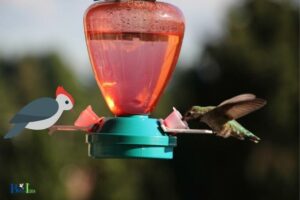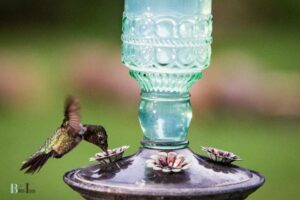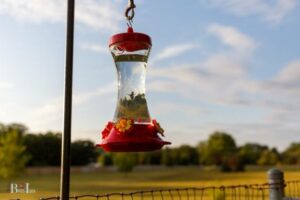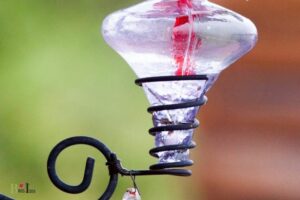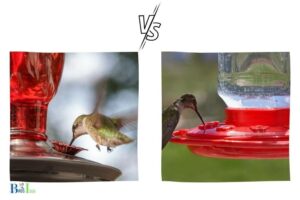Why do My Hummingbird Feeders Leak: 7 Reasons!
Hummingbird feeders may leak due to improper sealing, temperature changes, damaged parts, or overfilling.
Hummingbird feeders may leak if they’re not filled to capacity. The seal is often formed by the liquid inside the feeder creating a vacuum.
If the feeder isn’t filled completely, this vacuum may not form properly, causing leaks.
Temperature changes can also cause leakage as the feeder might expand and contract, breaking the seal.
If the feeder has a poor design or is damaged, it may leak regardless of other factors.
To minimize leaks, always check your hummingbird feeder’s seals and ensure all parts are correctly assembled and tightened.
Choose a feeder made of durable materials and place it out of direct sunlight to ensure a stable temperature, reducing expansion or contraction that may cause leaking.
Regular maintenance and inspection are crucial in ensuring your hummingbird feeder stays leak-free, so you can provide an attractive and efficient feeding spot for these tiny creatures.
7 Reasons of Hummingbird Feeders May Leak: Possible Solutions
| Reasons for Leakage | Explanation | Possible Solutions |
|---|---|---|
| Poor design | Some hummingbird feeders have design flaws that make them prone to leakage. | Choose feeders with better design and reviews. |
| Overfilling | Filling the feeder to the brim can cause leakage due to expansion when the liquid gets warm. | Fill the feeder only to the appropriate level, leaving some space for expansion. |
| Temperature fluctuations | Changes in temperature can cause the liquid to expand or contract, pushing it out through the feeding ports. | Place the feeder in a location with minimal temperature fluctuations, such as in the shade. |
| Damaged or worn parts | Cracks, splits, or worn seals in the feeder can cause leaks. | Inspect the feeder regularly and replace any damaged parts. |
| Improper assembly | If the feeder is not assembled correctly, it may not seal properly, causing leaks. | Ensure all parts are correctly aligned and tightened during assembly. |
| Inverted feeders | Inverted feeders rely on a vacuum seal to prevent leaks, and this seal can be compromised by factors like air bubbles or improper assembly. | Check for air bubbles and ensure proper assembly, or consider a different feeder design. |
| Animal interference | Squirrels or other animals may damage the feeder, leading to leaks. | Use squirrel guards or place the feeder in a location inaccessible to other animals. |
Key Takeaway
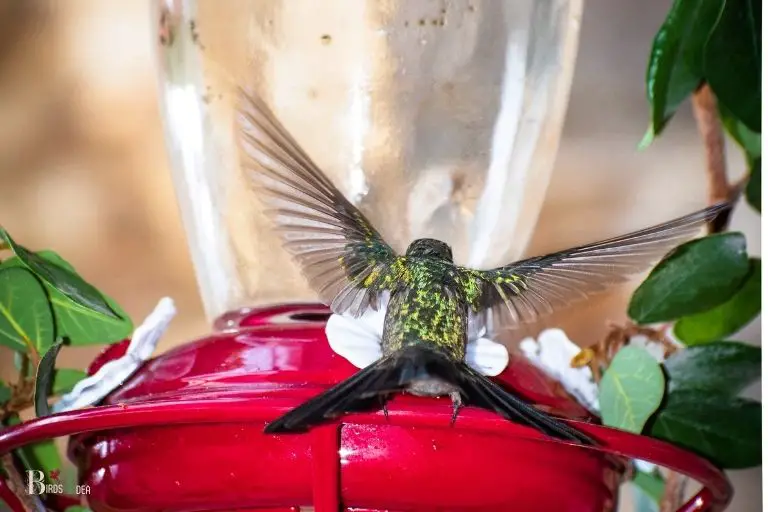
Five Facts About: Hummingbird Feeder Leaks
Troubleshooting Leaking Hummingbird Feeders
Leaking hummingbird feeders can be frustrating for bird lovers, as it not only wastes the nectar but also attracts ants and other pests.
There can be several reasons behind a leaking feeder, such as improper sealing, temperature changes, or damage.
To effectively troubleshoot and fix the issue, you need to identify the cause and follow the appropriate solution.
To help you out, here’s a guide on various causes and remedies for leaking hummingbird feeders.
Possible Causes & Remedies:
- Improper sealing: Ensure that all parts are assembled correctly and tightly secured, making sure the seal is working effectively. You can replace worn-out or cracked seals with new ones.
- Temperature changes: Hummingbird nectar can expand and contract due to temperature fluctuations, causing the feeder to leak. To avoid this, place your feeder in a shady area or one with minimal temperature variation.
- Cracked or damaged feeder: Inspect the feeder for any cracks or damage, and replace the damaged parts or the entire feeder if needed.
- Overfilled feeder: Avoid overfilling the feeder, as it can lead to leaking. Leave some space at the top to prevent overflow.
- Air pressure imbalance: Some feeders may leak due to air pressure imbalances. Try releasing some air by opening the feeder and turning it upside down briefly, then close it again.
“One of the reasons for feeder leaks can be due to the tiny cracks or damages in the tube that results in air entering the container and causing the nectar to leak,”
Emily Jones
Factors that Can Cause Hummingbird Feeders to Leak
Leaking hummingbird feeders can be frustrating for bird enthusiasts as it often leads to wasted nectar and a mess in the surrounding area.
Several factors can cause your hummingbird feeder to leak, and identifying the cause is crucial to resolving the issue.
Some of the main reasons for a leaking hummingbird feeder include improper assembly, changes in air pressure, temperature fluctuations, and manufacturing defects.
- Improper assembly: components might not be tightly fitted or aligned.
- Changes in air pressure: differences in air pressure can force nectar out of the feeder.
- Temperature fluctuations: expansion and contraction of the feeder and nectar cause leaks.
- Manufacturing defects: cracks or poor quality materials can lead to leaks.
Identifying the Causes of Leaking Hummingbird Feeders
Leaking hummingbird feeders can be problematic as they not only waste the nectar but also attract ants and other insects.
There is a range of causes for leaking feeders, and identifying these causes is essential in maintaining a clean and efficient feeding environment for the birds.
Some factors that contribute to the leakage include temperature fluctuations, overfilling the feeder, damaged or poorly sealed parts, and improper hanging of the feeder.
By understanding and addressing these issues, you can prevent leakage and maintain a clean and appealing feeding station for hummingbirds.
- Temperature fluctuations: As the outdoor temperature changes, the nectar inside the feeder can expand or contract, causing it to leak out of the feeding ports.
- Overfilling the feeder: Filling the feeder to the brim can cause the nectar to spill out when birds feed or when the temperature changes.
- Damaged or poorly sealed components: Cracks, dents, and loose seals can all cause leaks, especially in plastic feeders. Check for damage and replace parts as needed.
- Improper hanging: Ensure that your hummingbird feeder is hung correctly, with the feeding ports facing upwards, to prevent nectar spills and also attract more birds.
Regularly clean and inspect your hummingbird feeder to detect any damage or leakage in its early stages.
Make sure to completely empty and clean the feeder at least once a week to prevent mold growth and ensure fresh nectar for your hummingbird visitors.
How to Fix a Hummingbird Feeder That is Leaking
A hummingbird feeder may leak due to various factors such as temperature fluctuations, worn-out parts, or improperly assembled components.
To fix a leaking hummingbird feeder, it’s essential to identify the root cause and address it accordingly.
A simple solution may involve adjusting the feeder’s design, replacing damaged parts, or ensuring proper assembly.
Here is a list of steps to follow when fixing a leaking hummingbird feeder:
- Inspect the feeder: Check for cracks, loose or worn-out parts, and improperly assembled components. These could be potential causes of the leak.
- Replace worn-out parts: If you find any damaged parts, replace them with new ones to ensure a tight seal.
- Ensure proper assembly: Make sure that all parts are correctly assembled and tightly secured. This includes checking the vacuum seal and the positioning of the feeder so that it isn’t tilted or hanging unevenly.
- Adjust for temperature fluctuations: Temperature changes can cause the feeder to leak as the liquid inside expands and contracts. Place the feeder in a location with consistent temperature or select a feeder model designed to handle temperature fluctuations.
- Maintain cleanliness: Ensure the feeder is clean, as dirt and debris can compromise the vacuum seal or create blockages that cause leaks.
Tips to Prevent Leaking Hummingbird Feeders
Leaking hummingbird feeders can be a frustrating issue for those trying to attract and feed these beautiful birds.
There are several reasons why your hummingbird feeder may be leaking, including temperature fluctuations, manufacturing defects, and improper assembly.
Fortunately, there are measures you can take to prevent leaks from occurring and maintain a clean and efficient feeding environment for hummingbirds.
To prevent leaks and keep your hummingbird feeder functioning properly, consider these tips:
- Choose a high-quality feeder made from durable materials, such as glass or heavy-duty plastic.
- Ensure proper assembly by following the manufacturer’s instructions closely.
- Fill the feeder to the appropriate level, avoiding overfilling or underfilling.
- Use the right nectar formula; too thin or too thick mixtures can cause leaks.
- Regularly clean and inspect the feeder for damage or wear and replace parts as needed.
- Position the feeder in a sheltered area away from direct sunlight and wind to minimize temperature fluctuations.
DID YOU KNOW
According to a survey conducted by the National Audubon Society, leaky feeders can waste up to 20% of the nectar solution, leading to an unhealthy environment around the feeder and reduced attraction for the hummingbirds.
birdsidea
How do you keep hummingbird feeders from dripping?
Hummingbird feeders can often leak due to a variety of reasons such as changing atmospheric conditions, the quality of the feeder, or lack of proper maintenance.
To prevent dripping or leakage from your hummingbird feeder, follow these simple steps:
- Choose a high-quality feeder with a built-in ant moat to prevent insects from getting inside the feeder and clogging the feeding ports.
- Keep the feeder in a shaded area to prevent direct sunlight from heating the nectar and causing expansion.
- Tighten all screws and fittings on the feeder to ensure a secure fit and prevent leaks.
- Regularly clean the feeder and replace the nectar every few days to prevent mold or bacteria growth.
- Use a dripless feeder design that prevents drips from forming before they can fall from the feeder.
By following these steps, you can ensure that your hummingbird feeder remains leak-free and provides a safe and enjoyable feeding experience for these tiny birds.
What is the liquid in a hummingbird feeder?
Hummingbird feeders are designed to hold a nectar solution that is similar in composition to the natural nectar found in flowers.
The liquid typically used in a hummingbird feeder is a mixture of four parts water to one part white granulated sugar, which is then boiled until the sugar dissolves, and then cooled before being added to the feeder.
If your hummingbird feeder is leaking, it could be due to a variety of reasons such as a crack in the feeder, damage to the seal or improper cleaning.
It is important to regularly clean your feeder and replace the nectar every few days to prevent bacterial growth, which could also lead to leakage.
In addition, make sure the feeder is placed in a shady area away from direct sunlight to prevent the nectar from fermenting and evaporating too quickly.
Using a higher ratio of sugar to water may also cause the liquid to thicken and become more syrupy, leading to leakage.
FAQ of Why Do My Hummingbird Feeders Leak
Why do my hummingbird feeders seem to be leaking?
Another possible cause is that the feeder port holes may not be completely sealed when they are screwed in place, allowing the nectar to escape.
Additionally, over time, the feeder may become worn or damaged, causing it to leak.
What can I do to fix a leaking hummingbird feeder?
Additionally, inspect the feeder and the feeding ports to ensure there are no cracks or uneven sealing causing the nectar to escape. If necessary, replace the feeder with a new one.
How often should I clean my hummingbird feeder?
If you live in a very hot and humid climate, it’s advised to clean your feeder more often, to prevent the nectar from becoming diluted.
How can I make sure I’m feeding hummingbirds the proper nectar?
Conclusion
In conclusion, leaking hummingbird feeders can be frustrating for any bird enthusiast. There are several factors that can cause this issue, including a damaged or worn-out seal, improper assembly, or extreme temperatures.
Identifying the cause of the leak is key to fixing the problem. Some simple solutions include tightening the feeder’s cap, replacing the seal, or adjusting the feeder’s positioning.
Additionally, preventative measures like regular cleaning and maintenance can prolong the life of your hummingbird feeder and prevent future leaks.
By taking the necessary steps to troubleshoot and prevent leaks, you can ensure a delightful and hassle-free hummingbird feeding experience.

